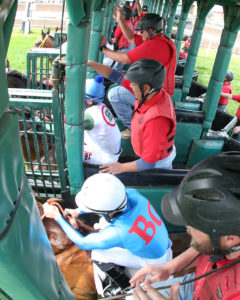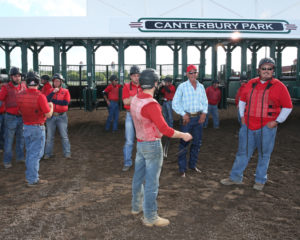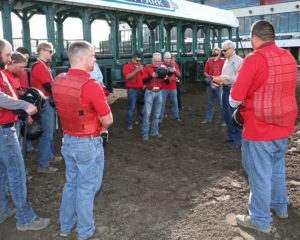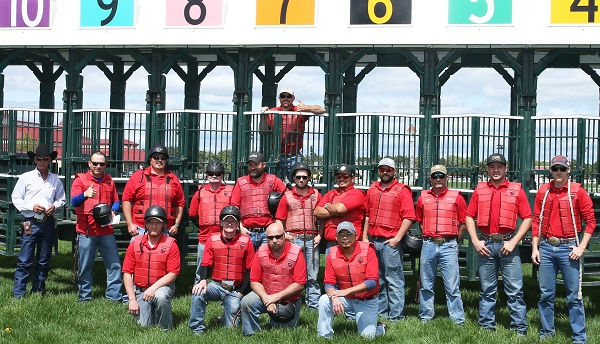BY JIM WELLS
Can you scoff at danger and inevitable injury, laugh off what happened twenty minutes earlier and focus on what’s about to take place? Can you forget about a throbbing leg kicked earlier in the day or an aching shoulder that acts up every time you lift an arm?
Can you do all of that and more despite wondering deep down why you do the job in the first place?
If yes, then you might be able to work the starting gate.
Race fans are aware of the gate crew’s presence mostly on a peripheral level, their attention typically focused on the horses as they load, theirs in particular, and then on the stall doors just before the field’s release.
Was it a clean break? Or did mine stumble and spring late from the gate?
The crew was doing it’s damndest to assure an equitable break for all, but they appear as mere figures in matching uniforms to fans whose focus is primarily on their betting interests.
The gate crew is charged also with the safety of horse and rider in a confined metal stall, yet plays mostly an obscure role and exists typically at the edge of our awareness in the hurry-scurry process of loading horses and the break thereafter.
The job is often described as the most dangerous at the racetrack, pitting a human being against an animal five times larger and infinitely stronger, an eleven-hundred pound animal, or more, capable of flipping over backward or worse within very narrow confines.
Horses have been known to leave one stall for another, catapult from one stall to the next or worse, their flailing, kicking legs capable of inflicting real damage on anything in the way.
There is reason the individuals who do these jobs are required to wear helmets and flak jackets. Yet, none of that would have helped a member of the Canterbury Downs crew in the late 1980s that was killed after slipping from the gate as it was pulled away in front of the grandstand. The death of Bobby Compton created changes in policy at tracks around the country. Crew members were prohibited thereafter from riding in stalls as the gate was being transported.

Darrin Hall is the starter at Canterbury Park and works the gate at Turf Paradise in Phoenix during the autumn and winter meets. He has been doing this kind of work since he outgrew the jockey profession.
He has brothers, two older, two younger, who do or did the same thing and recalls making a statement to one of them after his first few days on the job. “Why would anybody do this for a living?” he asked.
That was in 1984.
Yet, here he is, and with stories his younger colleagues never tire of hearing.
Hall began his career during a time when 12-horse fields were commonplace, increasing chances for mayhem at the gate with every race. He got his start in Wyoming but has spent the last three decades in Arizona, where he works Turf Paradise after originally working the former Yavapai Downs meet in Prescott, where he witnessed perhaps the all-time episode of his career.
The incident was extreme. A horse flipped over in the gate and was turned the wrong way before jumping onto the back of the horse in the next stall. Then he began pawing the horse next door. From the No. 6 hole into the No. 7 to the No. 8, before bounding over the tailgate and out of the stall.
Tahitian Tease: hard to forget a horse like that. “The trainer remarked that she was feeling a little spunky that day,” Hall recalled. “Well….if you want to call it that.”
Oscar Quiroz, an Arizona native, has worked previously in Prescott, Rillito Park in Tucson and spends his autumns and winters the last few years on the gate at Turf Paradise in Phoenix.
Hall recalls Quiroz’s first episode with a flipping horse in the gate. “Welcome to the NFL,” he told him.
Quiroz was trapped once in a stall with a fractious horse. “With its head alone, that horse threw me into the next stall,” he said. “And I’m not a small person.”
Suffice to say Oscar weighs in at, oh, NFL lineman standards.
A recent gate incident left Quiroz limping for a few days after a horse pinned his thigh to the metal wall of the stall with its leg while he avoided getting kicked by grabbing the horse’s hoof with a free hand.

Jake Barton retired from riding two years ago and almost immediately hooked up with Hall, a friend since boyhood, on the crew in Phoenix.
“If you want to be the best, you have to learn from the best,” he explained. “Darrin’s been at this a long time and knows what he’s doing.”
Barton compares this work with what a rodeo clown does in his arena, keeping the rider safe especially when he can’t help himself, after a horse has reared and perhaps trapped him in the stall. Typically, a rider gets thrown out the back of the gate when a horse flips, but sometimes he gets lodged between the horse and the walls or back gate or, worse yet, underneath the horse.
“It’s our job to get between him and the horse then,” Barton explained. “To make sure he’s okay.”
Barton says he’s been hurt more often as a rider than he has since joining the Phoenix gate crew two years ago, but knows injuries are part of the job nonetheless.
“Sometimes we might have to take one for the rider if a horse flips,” he said. “That’s just part of the job.”
At the same time, he says that all riders should have to work the gate at some time to learn that aspect of the job, to better understand what a gateman goes through.
“Basically,” he says, “we’re in there to babysit the horse so they can get the best break possible, and to keep that rider safe.”
Sometimes a gateman has to assist one of his colleagues, help him out of an impossible situation. The one time, for example, that a horse had a leg over Quiroz and pinned in the stall. “Big O’s three times my size and he couldn’t get out,” Barton said. “That tells you what kind of force you’re playing with in there. There’s no give when you get slapped between a horse and a steel wall.”
Races are sometimes altered by what transpires in the gate. “If a horse flips in a gate, he should be scratched, ”said Hall. “He’s already run his race the way I see it. If a horse throws a fit in the gate, he’s already run half a race. He won’t run his best.”
Brian Brock’s transition to working the gate came somewhat differently than many of the hands with whom he works. He grew up in Washington and his father rode at Hastings Race Track in Vancouver, British Columbia.
“I was at the racetrack from the time I was a little kid,” he said. “Washing tubs and water buckets, eventually hot-walking horses.”
Brock, who wrestled at 145 pounds, was too big to ride, but he did eventually find work at Turf Paradise nine years ago grooming horses for trainer Valorie Lund. He began working the gate two years ago and says there is an emotional element to the job.
“It’s sort of an adrenaline rush,” he said. “It’s kind of hard to explain, but it is a bit of a high. There is just you and that horse….trying to get along.”
So far, so good. No serious injuries.
“Nothing major,” he said. “Shoulder, foot stomped on, soreness.”
He had one thrashing about that threw him against the tailgate last winter but was able regain his feet on the pontoons on each side of the stall. The job requires rigorous safety awareness down to the finest detail.
On a trip in the pickup to the gate during a recent race card at Canterbury, Dillon Lynn stopped the vehicle to pick up a paper cup that had found its way to the racetrack.
It’s thoroughness with this job…safety first. Any distraction on the course can spell mayhem if a galloping horse shies into the path of a horse next to him or tries to jump an object.
At the very least, it could affect the outcome of a race.
A clean break is often only the start of a clean trip.
